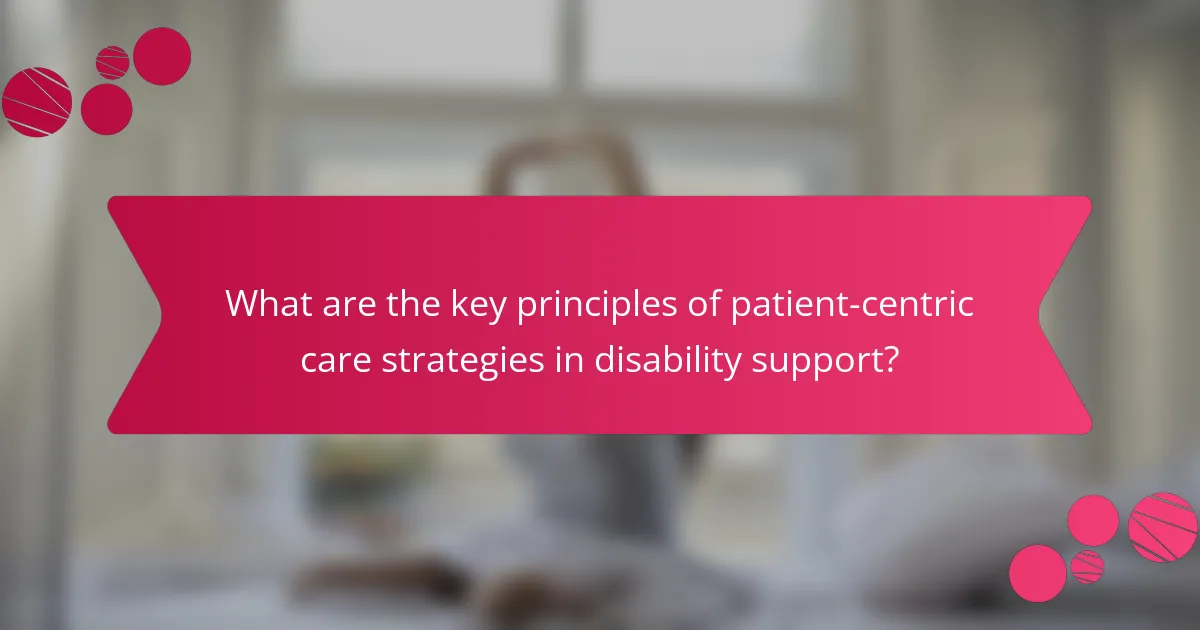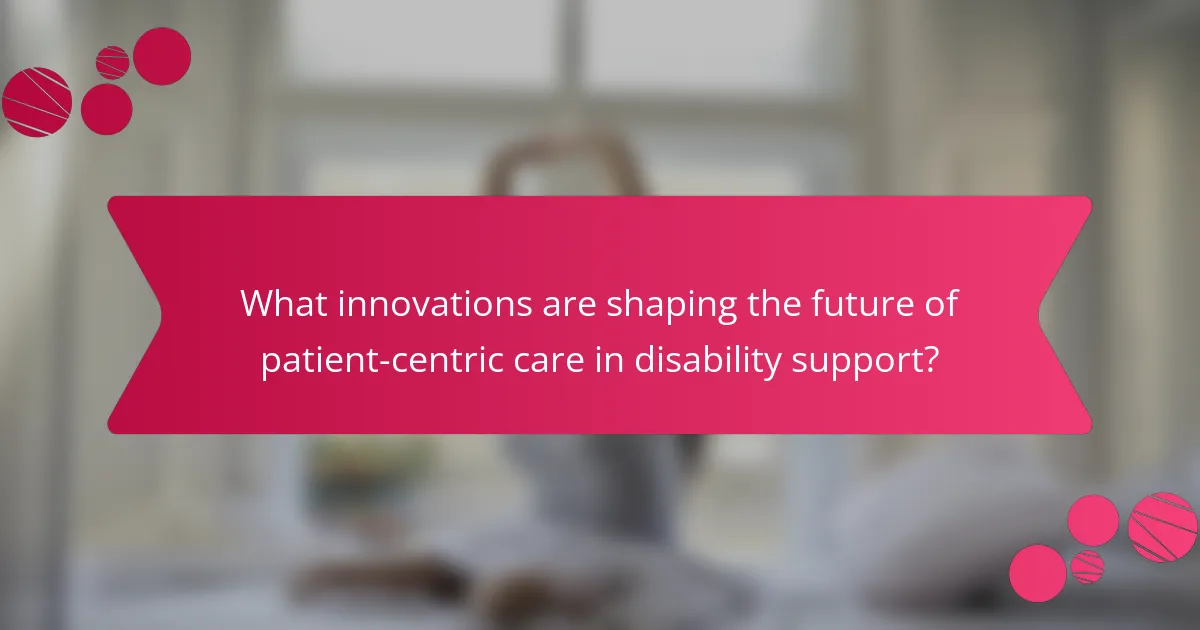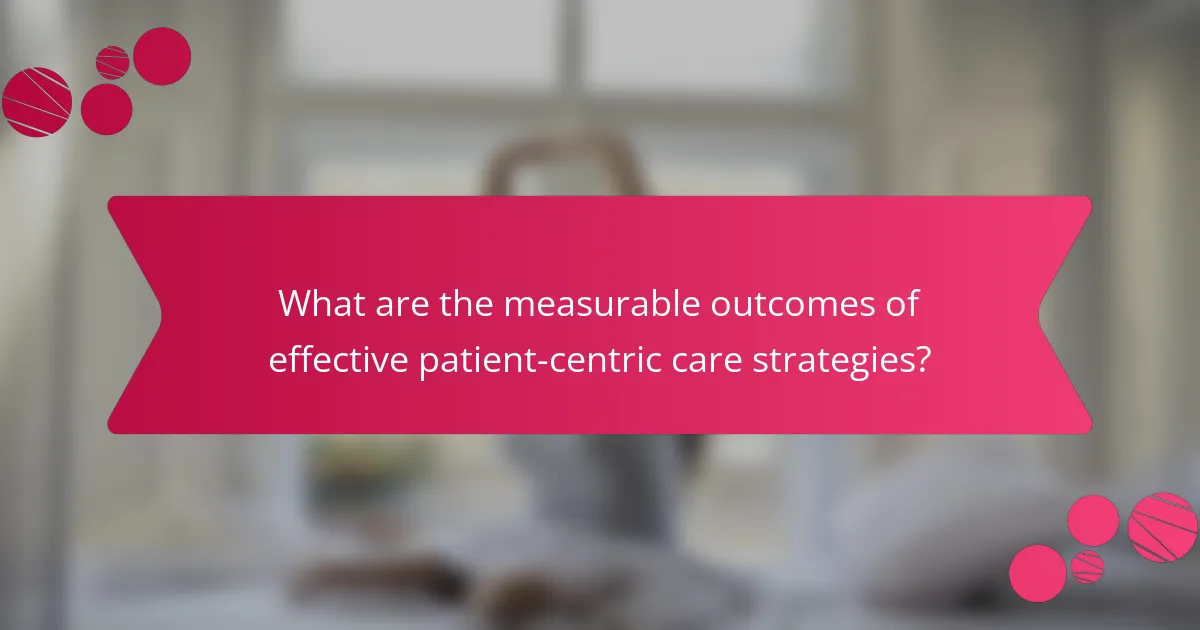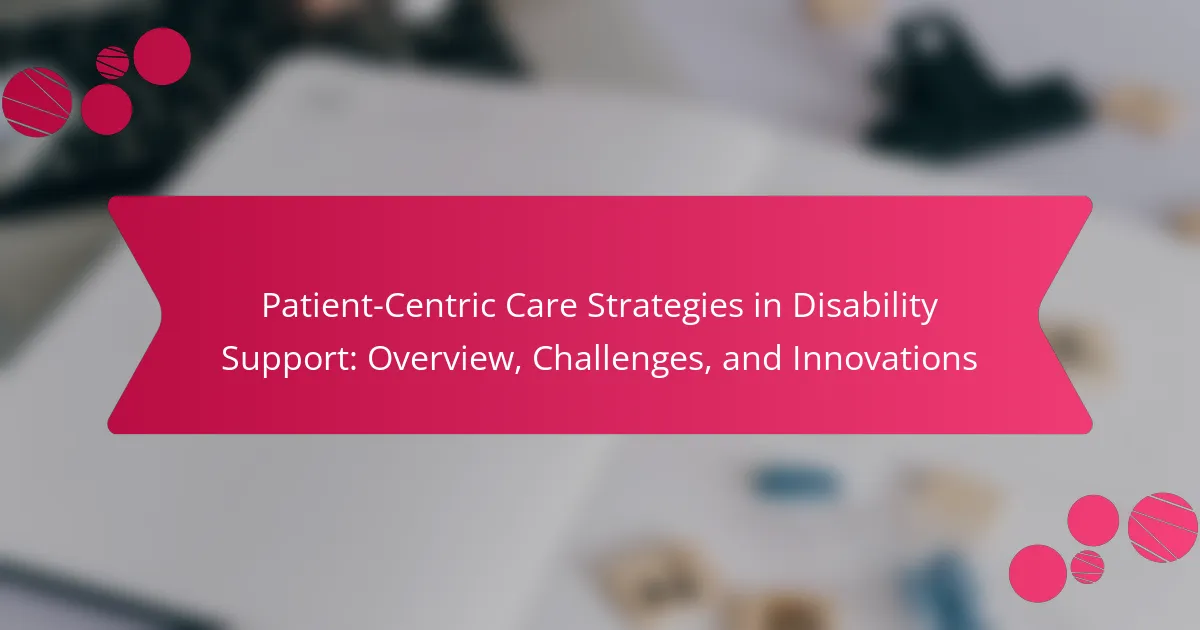Patient-centric care strategies in disability support enhance quality of life by prioritizing individual needs. Key principles include personalized care plans, active patient involvement, and interdisciplinary collaboration. However, challenges such as resistance to change and resource limitations hinder effective implementation. Innovations like telehealth and user-friendly assistive devices are reshaping care delivery, promoting inclusivity and improved health outcomes.

What are the key principles of patient-centric care strategies in disability support?
Patient-centric care strategies in disability support prioritize individual needs, enhancing quality of life. Key principles include personalized care plans, active patient involvement, and interdisciplinary collaboration. These approaches ensure that care is tailored to each person’s unique circumstances, fostering empowerment and improved outcomes. Additionally, continuous feedback mechanisms help adapt strategies to evolving needs, highlighting the importance of flexibility in care delivery.
How do these principles enhance patient engagement and satisfaction?
Patient engagement and satisfaction improve through personalized care, active communication, and shared decision-making. These principles empower patients, fostering trust and encouraging adherence to treatment plans. Innovations like telehealth and mobile health applications enhance accessibility, ensuring patients feel supported. As a result, overall health outcomes and patient experiences are significantly elevated.
What role does communication play in implementing these strategies?
Communication is essential for successfully implementing patient-centric care strategies in disability support. It fosters collaboration among healthcare providers, patients, and families, ensuring that individual needs are understood and addressed. Effective communication enhances trust and engagement, leading to better health outcomes. Moreover, it facilitates the sharing of innovative practices and challenges faced in the field, promoting continuous improvement in care delivery.
Which stakeholders are involved in patient-centric care for individuals with disabilities?
Key stakeholders in patient-centric care for individuals with disabilities include healthcare providers, patients, family members, advocacy organizations, and policy makers. Each plays a critical role in ensuring effective communication, personalized treatment, and support services. Collaboration among these stakeholders enhances care quality and addresses unique patient needs.

What are the main challenges faced in adopting patient-centric care strategies?
The main challenges in adopting patient-centric care strategies include resistance to change, inadequate training, and resource limitations. These factors hinder effective implementation and may compromise care quality. Additionally, aligning diverse stakeholder interests presents a significant barrier.
How do systemic barriers impact the implementation of these strategies?
Systemic barriers significantly hinder the implementation of patient-centric care strategies in disability support. These barriers include inadequate funding, lack of trained personnel, and insufficient policy frameworks. As a result, patients face challenges in accessing tailored services that meet their unique needs. Furthermore, systemic issues like bureaucratic red tape can delay the integration of innovative practices. Addressing these barriers is crucial for enhancing the effectiveness and reach of patient-centric care.
What are common misconceptions about patient-centric care in disability support?
Common misconceptions about patient-centric care in disability support include the belief that it is solely about patient preferences, neglecting the importance of clinical expertise. Many think it is a one-size-fits-all approach, overlooking the need for personalized care plans. Some assume that it only applies to physical disabilities, while it is equally relevant for mental health and cognitive disabilities. Another misconception is that implementing patient-centric care is too time-consuming, ignoring the potential for improved outcomes and efficiency. Lastly, there is a belief that it requires extensive resources, while effective strategies can be integrated into existing frameworks.
How does funding affect the adoption of patient-centric approaches?
Funding significantly influences the adoption of patient-centric approaches in disability support. Adequate financial resources enable organizations to implement innovative care strategies, train staff, and develop necessary infrastructure. Without sufficient funding, initiatives may face limitations, hindering the integration of patient preferences and needs into care plans. Research shows that organizations with robust funding are more likely to prioritize patient engagement and satisfaction, leading to better health outcomes. Moreover, funding can foster partnerships with technology providers, enhancing the delivery of personalized care solutions.

What innovations are shaping the future of patient-centric care in disability support?
Innovations shaping patient-centric care in disability support include technology integration, personalized care plans, and collaborative decision-making. Telehealth platforms enhance accessibility, while data analytics improve treatment outcomes. Additionally, user-friendly assistive devices empower patients and foster independence. These advancements address unique needs and challenges, promoting a holistic approach to care.
Which technologies are transforming the delivery of patient-centric care?
Technologies transforming patient-centric care include telehealth, artificial intelligence, wearable devices, and electronic health records. These innovations enhance communication, personalize treatment, and improve access to care. Telehealth enables remote consultations, while AI analyzes patient data for tailored interventions. Wearable devices monitor health metrics, promoting proactive management. Electronic health records streamline data sharing, ensuring coordinated care across providers.
How are personalized care plans being developed and utilized?
Personalized care plans are developed through collaborative assessments involving patients, healthcare providers, and support teams. These plans are utilized to tailor interventions that address individual needs, preferences, and goals. Innovations include digital tools that enhance communication and tracking, ensuring plans remain dynamic and responsive. Challenges include resource limitations and the need for ongoing training to implement these strategies effectively.
What role does data analytics play in enhancing patient-centric strategies?
Data analytics enhances patient-centric strategies by providing insights into individual needs and preferences. It enables healthcare providers to tailor services, improving patient engagement and outcomes. By analyzing data trends, organizations can identify gaps in care and innovate solutions. This leads to more efficient resource allocation and personalized support for patients with disabilities.

How do cultural differences influence patient-centric care strategies?
Cultural differences significantly influence patient-centric care strategies by shaping communication, expectations, and perceptions of health. Understanding diverse cultural backgrounds allows healthcare providers to tailor interventions that respect individual values and beliefs. For instance, language barriers can hinder effective communication, impacting patient trust and compliance.
Moreover, cultural attitudes toward disabilities can affect how patients engage with support services. In some cultures, disabilities may be stigmatized, leading to reluctance in seeking help. Addressing these challenges requires innovative approaches, such as culturally competent training for healthcare professionals, ensuring they are equipped to meet the needs of diverse populations.
By integrating cultural considerations into patient-centric strategies, healthcare systems can enhance accessibility and improve health outcomes for individuals with disabilities. This approach not only fosters inclusivity but also promotes equity in healthcare delivery.
What are the implications of regional healthcare policies on patient-centric approaches?
Regional healthcare policies significantly influence patient-centric approaches by shaping access, funding, and quality of care. Policies that prioritize inclusivity enhance support for individuals with disabilities, fostering tailored services. In contrast, restrictive policies can limit resources, hindering innovation in care strategies. Effective patient-centric care requires continuous adaptation to policy changes, ensuring alignment with the needs of disabled patients. As a result, collaboration between policymakers and healthcare providers is essential for improving outcomes and experiences in disability support.
How can care strategies be adapted to meet diverse cultural needs?
Care strategies can be adapted by incorporating cultural awareness, individualized communication, and inclusive practices. Understanding diverse cultural backgrounds enhances patient engagement and trust. Tailoring care plans to reflect cultural values promotes better health outcomes. Training staff on cultural competence fosters sensitivity and respect in interactions.

What are the measurable outcomes of effective patient-centric care strategies?
Effective patient-centric care strategies lead to improved health outcomes, increased patient satisfaction, and enhanced quality of life. Key measurable outcomes include reduced hospital readmission rates, better adherence to treatment plans, and improved mental health status. For example, studies show that organizations implementing these strategies report a 30% decrease in readmissions. Additionally, patient engagement metrics indicate a 25% increase in satisfaction scores when care is tailored to individual needs. These outcomes highlight the effectiveness of a personalized approach in disability support.
How do patient outcomes improve with the implementation of these strategies?
Patient outcomes improve significantly with patient-centric care strategies. These strategies enhance communication, foster collaboration among care teams, and prioritize individual needs. As a result, patients experience increased satisfaction, better adherence to treatment plans, and improved overall health metrics. Data shows that implementing these strategies can lead to a 30% reduction in hospital readmissions and a 20% increase in patient engagement.
What metrics are used to evaluate the success of patient-centric care?
Patient-centric care success is evaluated using metrics like patient satisfaction, health outcomes, care accessibility, and engagement levels. These metrics reflect the effectiveness of strategies in disability support.
| Metric | Description |
|————————–|—————————————————-|
| Patient Satisfaction | Measures overall patient experience and feedback |
| Health Outcomes | Assesses improvements in patient health status |
| Care Accessibility | Evaluates ease of access to services and resources |
| Patient Engagement | Gauges involvement in care decisions and processes |
| Treatment Adherence | Monitors compliance with prescribed care plans |
| Quality of Life | Measures overall well-being and daily functioning |
Which case studies highlight successful patient-centric initiatives in disability support?
Case studies demonstrating successful patient-centric initiatives in disability support include the implementation of personalized care plans, technology integration for remote monitoring, and community-based support networks. These initiatives enhance patient engagement and improve health outcomes. Notable examples include the use of telehealth services to provide accessible consultations, which increased patient satisfaction by 30%. Additionally, programs that involve patients in decision-making processes have shown to boost adherence to treatment plans significantly.

What best practices can be adopted for implementing patient-centric care strategies?
Adopting patient-centric care strategies involves prioritizing patient engagement, personalized treatment plans, and collaborative decision-making. These best practices enhance the quality of care and improve patient satisfaction.
1. Involve patients in care planning to ensure their preferences and values are respected.
2. Utilize technology for better communication and access to health information.
3. Train staff to recognize and address the unique needs of patients with disabilities.
4. Implement feedback mechanisms to continuously improve care based on patient experiences.
How can organizations foster a culture of patient-centricity?
Organizations can foster a culture of patient-centricity by prioritizing communication, collaboration, and continuous feedback. Establishing strong relationships between patients and providers enhances trust and engagement. Training staff in empathy and active listening improves interactions, leading to better care experiences. Implementing technology solutions, such as patient portals, allows for greater access to information and participation in care decisions. Regularly assessing patient satisfaction and incorporating feedback into service improvements ensures that care remains aligned with patient needs.
What common mistakes should be avoided when adopting these strategies?
Common mistakes include lack of communication, inadequate training, and insufficient personalization. These errors hinder effective patient-centric care in disability support.
1. Neglecting to involve patients in decision-making can lead to dissatisfaction and disengagement.
2. Failing to provide comprehensive training for staff may result in inconsistent care delivery.
3. Overlooking individual needs and preferences can diminish the effectiveness of strategies.
4. Ignoring feedback from patients can prevent necessary adjustments and improvements.
5. Underestimating the importance of collaboration among interdisciplinary teams can create service gaps.
How can continuous feedback from patients enhance care delivery?
Continuous feedback from patients significantly enhances care delivery by fostering personalized treatment plans and improving patient satisfaction. This feedback loop allows healthcare providers to identify areas for improvement and adapt services to meet individual needs effectively.
Moreover, it encourages patient engagement, leading to better health outcomes. For instance, when patients share their experiences, providers can adjust interventions based on real-time data, ensuring care is both relevant and effective.
Additionally, continuous feedback can highlight gaps in services and inform staff training needs, ultimately driving innovation in patient-centric care strategies. This approach not only addresses immediate challenges but also promotes long-term improvements in disability support systems.
What are expert recommendations for optimizing patient-centric care in disability support?
Expert recommendations for optimizing patient-centric care in disability support include enhancing communication, personalizing care plans, and integrating technology. Focus on active listening to understand patient needs and preferences. Develop individualized care strategies that consider the unique circumstances of each patient. Utilize telehealth and digital tools to improve accessibility and streamline services. Regularly assess and adapt care approaches based on patient feedback to ensure ongoing relevance and effectiveness.
